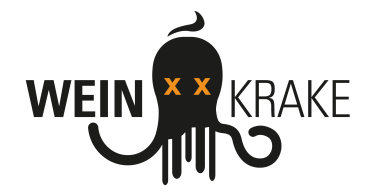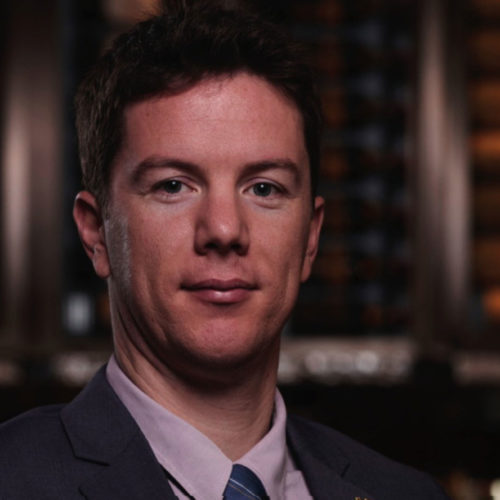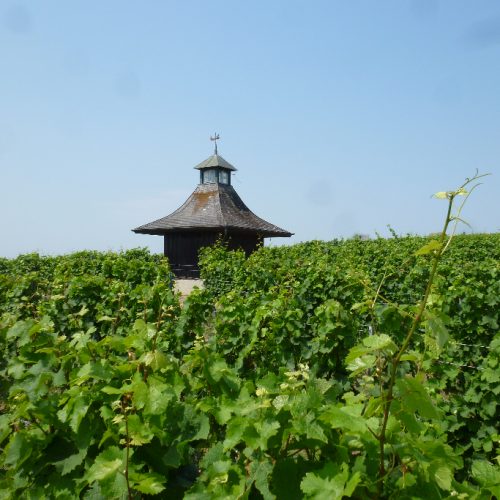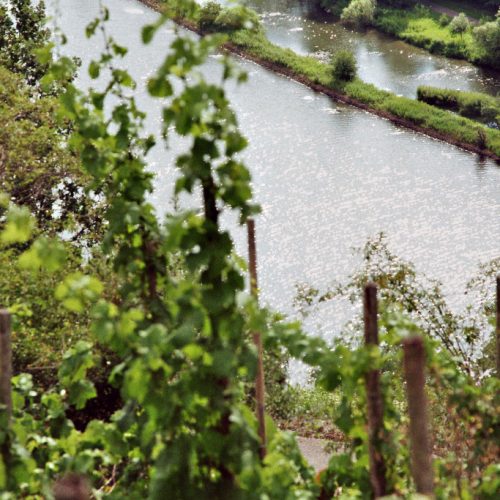THE WINES
-2014 Sauvignon Blanc
This wine is pure and mixed. That might sound paradox, but it works. In the bottle there is only one grape variety filled in – Sauvignon Blanc. But the grapes are from different locations and vines. This mixture surrounds the DNA of the Sauvignon Blanc and brings completely diverse flavours together to create an amazing diversity. To be exact: The new world of stylistics and an old world of backbone come together. Gooseberry and passion fruit as modern interpretations exist next to grassy, mineral notes and a tense sourness – a cosmopolitan from the Pfalz.
-2014 Sauvignon Blanc Fumé
We want smokers! Because smokers win – but not in this case. Still, whoever gives himself over to those through wood extracted smoky notes, that remind oneself of almonds, yeast and nuts, will be rewarded. Because next to them, it is not easy for the freshness of the sourness and the sweetness of the fruit to brave the wood and make everything seem harmonious. And that is exactly what is happening. A Sauvignon Blanc is being presented which combines the complexity of the impressions. In this case, Zeter proves a lot of sensitiveness. A wine with lots of flint – be careful for inflammable explosions of happiness.
-2014 Viognier
Sometimes it just feels good to think about the Pfalz. So let us think about Viognier in the first place. Thanks to the climate change, there is now cultivation of Viognier in Germany as well. There is not much, but at least something over four hectare. Only a hand full of wine makers dare to grow it – Mister Zeter is one of them. This grape needs a lot of affection of the wine maker and the gourmet. The last one of them should have desire and take some time to encounter this wine. Because it is an encounter of a different kind. It is a game between opulence and elegance with lots of intensity in the bouquet and much exotic fruit. And then it keeps going on the palate: You have got elegant sourness, a very fine texture, elegant use of wood and a melting outflow. So there is a lot of space for complex drinkers.
– 2012 Z Rotwein
This red wine is called Z. „Z“eters most personal wine? Or is just the last letter of the alphabet and a wine from the last rows? Well, at least it was the official wine of the Berlinale in 2012. And brings strength from the Pfalz on to the palate. Juicy and spicy. Silky tannins, structure and a long outflow are a lot of fun.
THE INTERVIEW
You only became a wine maker late, even though you have been in this industry for quite some time. Why was it such a late realisation?
It was actually pretty clear that I was going to do something in the wine industry. I did not have a vineyard though, even if I or my parents might have wished for one. Instead, there was a wine importing firm which my father had established since 1987. And simply because of that, it was easy to get involved because it already had to do with wine. After my time in South Africa I went to Hamburg and worked there for eleven years. But after those years I wanted to go back to the Pfalz – I wanted to enjoy myself and do the things I had always wanted to do, namely my own wine. And in 2004 I started to plant the first grapes.
Did you have to buy land for that?
No. My second cousin had some land, but he was unsatisfied. He is a lawyer and did not have so much interest. So I got an old vineyard which was badly cultivated. I began to dig everything up and started planting Sauvignon Blanc and Viognier. Like this, I already had my own half hectare which I later successively bought.
This brave step also shows some kind of forthrightness to swim against the current. How would you describe your attitude towards life?
The phrase „against the current“ is actually pretty right. It was never my thing to be adapted. That surely is not the path of life with the least resistance, but it is simply more fun, especially with wine.
The decision to grow Sauvignon Blanc was a good one because there were many awards and it belongs to the best wines in Germany today. But why did you decide to grow this kind?
It is simple – being in love. And there is no stronger feeling than being in love. During my time in South Africa I just fell in love with the Sauvignon Blanc. It was incredible, how this wine tasted. It is so incredibly elegant, it has a lot of finesse and it feels good drinking it. It is no overly sophisticated wine – it is honest. It is playing with you in a way that actually only Riesling knows how to do. I have tried too many moderate Sauvignon Blancs in my life, and so I knew that I had to create an outstanding one.
What do you think about competition in the wine business?
Competition is good. Competition is encouraging. Because of competition you get to see, that German wine makers have got a good position. And even though I do not belong to the young generation anymore, I am excited about good results at the Sauvignon Blanc Trophy’s or tastings.
And what about the evaluation with credits?
It is only a means to an end. Everyone feels wine differently. To give credits is not something that is very reliable. The Germans are always looking to keep everything in the normal range, but I think that an evaluation with credits is only a rough direction.
It belongs to you as your brand logo – the bear. What story stands behind this striking image?
The bear was not drawn for the label. It is clearly older than you and me together. It was drawn in 1933. It must have been a funny evening: Eight men met in a back room at the regulars’ table in Neustadt. One of these men was my great-grandfather Walter Baer and another one a well-known painter called Otto Dill, specialised on paintings of animals. One evening, my great-grandfather did not have time to come to the regulars’ table. But for some reason the other men wanted to get in contact with him. Because of that, they created a postcard where they drew a bear that drank wine on the back. That must have happened in about five minutes because it only were a few pencil strokes. And then they sent this postcard to my great-grandfather Walter Baer.
And that was reason enough for you to bring the bear onto the label?
Well, we did not really do it purposely. I just found this bear so incredibly funny, and it is even hung up in our kitchen. I have asked myself very often what look this bear has: it is something between fierce and fun. And then I said to myself, that if I ever make some wine, I am going to make this my logo for the bottles. If I look back at this decision now, I can for sure say that it was a good one. Today, it really is our figurehead and it gives my wine a big recognition value.
What do the people say about the bear?
Everyone finds it pretty good. Ladies always say how lovely and cuddly it looks. But they also like it from an arty aspect. They just have to smile a little whenever they see it. And I personally cannot take my eyes off of the bear. As well as that, we would like to do some more with it. We are planning another collection with another bear which was drawn by the same artist for my great-grandfather. But I cannot say more about it – it is still top secret (laughing).
Rebranding for Berlin. That is really good, right?
A bear in Berlin. That would be pretty funny, but we do not want to make it too cute and nice and just count the complete biological family of the bear. You just should not stress it too much. The bear and Zeter belong together and that is it.
Your philosophy: Specialisation on specific terroirs. What does that mean and is it a recipe for the future?
We can definitely see clearly where the best locations for Sauvignon Blanc are. You might not believe it, but the lighter, more sandy and hot locations are not necessarily the best ones for Sauvignon Blanc in the Pfalz. We see, that chalk in combination with clay and sand is way more essential. For the first time, we filled 914 bottles of Chenin Blanc and brought it on to the markets. We have a very good location with lots of chalk. And you can tell that there is a difference. And I believe that this is ideal for Chenin Blanc. So, yes, terroir in its complexity is the recipe of the future.
Which role has Sauvignon Blanc for you, for Germany and for the whole world in the future?
For me personally, Sauvignon Blanc is the most important type of grape in the company. We have a large variety of this grape. You could probably even create a whole menu of it. Sparkling wine, basic Sauvignon, Fumé, sweet Sauvignon Sweetheart, Grappa Sauvignon and we are also going to create a completely new Sauvignon Blanc that is better than all the other kinds. A wine, that is more ambitious. Well, Sauvignon Blanc is a big deal for Germany. Even though Riesling is more popular, Sauvignon Blanc is going to win on popularity and importance in Germany and especially the Pfalz. Also, with my new wine we are going to be able to create a new top wine that is going to be internationally wanted – with the personality of the Pfalz and its very own identity from Germany. I am even going to predict that the German Sauvignon Blanc is going to be more popular than Chardonnay. If we talk about Sauvignon Blanc in a worldwide context, we should probably also talk about the Cool-Climate-Style from New Zealand. Even if the import to Germany was not as great in the last few years, which has something to do with the different qualities (smiles), I believe that those wines are often an easy to understand alternative. I can see both of them at eye level.
Is there something that you always wanted to tell the world?
I am just very happy that I am able to do something that I love and have fun with. I am living my life’s dream and I am living it very intensely at the moment. I am soaking it all up like a sponge and I am burning completely. To the readers from Berlin and Germany: I am simply very happy to have such a good and open environment. I am happy that young winemakers produce for younger and older people and that we do not have to drink what we fabricated in the past. It is booming in Germany and that is great.















